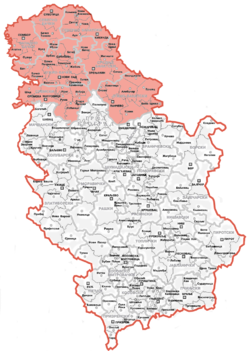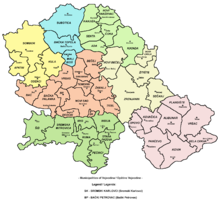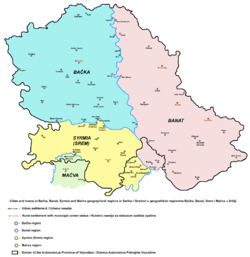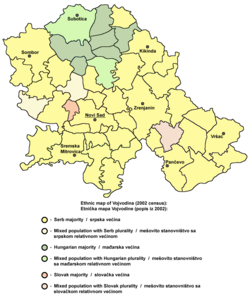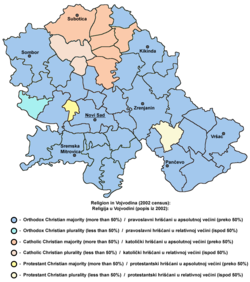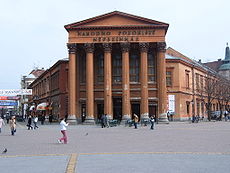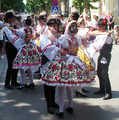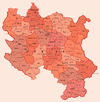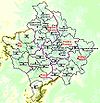- Vojvodina
-
This article is about the autonomous province within modern-day Serbia. For other uses, see Vojvodina (disambiguation). For Yugoslav provinces, see AP Vojvodina.
Autonomous Province of Vojvodina Аутономна Покрајина Војводина
Autonomna Pokrajina Vojvodina
Vajdaság Autonóm Tartomány
Autonómna Pokrajina Vojvodina
Provincia Autonomă Voivodina
Автономна Покраїна Войводина

Flag Coat of arms Vojvodina (red) is Serbia's autonomous provinceCapital
(and largest city)Novi Sad
45°19′N 19°51′E / 45.317°N 19.85°EOfficial language(s) Serbian, Hungarian, Slovak, Romanian, Croatian, Pannonian Rusyn1 Government Government - President of the Government Bojan Pajtić - Speaker of the Assembly Sándor Egeresi Autonomy - SAP Vojvodina 1945 Area - Total 21,506 km2 (n/a)
8,300 sq mi- Water (%) n/a Population - 2011 census 1,916 889 - Density 94.51/km2 (n/a)
36.49/sq miTime zone CET (UTC+1) - Summer (DST) CEST (UTC+2) 1 All the official languages are used in the provincial government; Serbian is used in all municipality governments; others are used in selected municipality governments. There exists newspapers, radio, TV shows, other media and the right of education on official and minority languages. Vojvodina, officially called Autonomous Province of Vojvodina (Serbian: Аутономна Покрајина Војводина, Autonomna Pokrajina Vojvodina [ʋɔ̌jʋɔdina] (
 listen); Hungarian: Vajdaság Autonóm Tartomány; Slovak: Autonómna Pokrajina Vojvodina; Romanian: Provincia Autonomă Voivodina; Croatian: Autonomna Pokrajina Vojvodina; Rusyn: Автономна Покраїна Войводина) is an autonomous province in Serbia. Its capital and largest city is Novi Sad. Vojvodina has a multi-ethnic and multi-cultural identity, with a number of mechanisms for the promotion of minorities; there are more than 26 ethnic groups in the province, which has six official languages.
listen); Hungarian: Vajdaság Autonóm Tartomány; Slovak: Autonómna Pokrajina Vojvodina; Romanian: Provincia Autonomă Voivodina; Croatian: Autonomna Pokrajina Vojvodina; Rusyn: Автономна Покраїна Войводина) is an autonomous province in Serbia. Its capital and largest city is Novi Sad. Vojvodina has a multi-ethnic and multi-cultural identity, with a number of mechanisms for the promotion of minorities; there are more than 26 ethnic groups in the province, which has six official languages.Contents
Name
The name "Vojvodina" in Serbian language means a type of duchy – more specifically, a voivodeship. It derives from the word "vojvoda" (see voivode) which stems from the Proto-Slavic language word "voevoda". Those words are etymologically connected with modern-day words "vojnik" (soldier) and "voditi" (to lead). Its original name (from 1848) was the "Serbian Voivodeship" (Srpska Vojvodina), but since Vojvodina is now a part of Serbia, the prefix "Serbian" is no longer needed.
The full official names of the province in all official languages of Vojvodina are:
- Аутономна Покрајина Војводина, Autonomna Pokrajina Vojvodina (in Serbian/Serbo-Croatian)
- Autonomna Pokrajina Vojvodina (in Croatian)
- Vajdaság Autonóm Tartomány (in Hungarian) (
 listen (help·info))
listen (help·info)) - Autonómna Pokrajina Vojvodina (in Slovak)
- Provincia Autonomă Voivodina (in Romanian)
- Автономна Покраїна Войводина (in Pannonian Rusyn)
Names in other languages that are not official in the province, but that are spoken by some local inhabitants:
- Autonomna Pokrajina Vojvodina, Аутономна Покрајина Војводина (in Montenegrin)
- Voyvodina (in Romani)
- Autonomna Pokrajina Vojvodina (in Bunjevac)
- Автономна Покраина Војводина (in Macedonian)
- Автономний край Воєводина (in Ukrainian)
- Autonomna Pokrajina Vojvodina (in Bosnian)
- Autonome Provinz Woiwodina (in German)
- Avtonomna pokrajina Vojvodina (in Slovene)
- Krahina Autonome e Vojvodinës (in Albanian)
- Автономна област Войводина (in Bulgarian)
- Autonomní oblast Vojvodina (in Czech)
History
Main article: History of VojvodinaThe territory of present-day Vojvodina throughout history
Banat, Bačka and Syrmia: throughout history, the territory of present day Vojvodina (including regions of Banat, Bačka and Syrmia) has been (entirely or partially) a part of:
- the State of the Scordisci (3rd century BC–1st century AD), with capital in Singidunum (present-day Belgrade),[1][2][3][4]
- Dacia (1st century BC),[5][6][7][8][9]
- the Roman Empire (1st-5th century),
- the Hun Empire (5th century),
- the Ostrogoth Kingdom (5th century),
- the Gepid Kingdom (5th-6th century),
- the Langobard State (6th century),
- the Byzantine Empire (6th century; 11th-12th century),
- the Avar Khanate (6th-8th century),
- the Frankish Kingdom (8th-9th century),
- the Principality of Pannonian Croatia (9th century),[10]
- the Principality of Lower Pannonia (9th century),[11]
- the Great Moravia (9th century) - according to various sources, Great Moravia included territory of present-day Vojvodina.[12][13][14] According to alternative theory presented by Peter Püspöki Nagy, Great Moravia was centered in present-day Serbia: around the river Velika Morava and in present-day Vojvodina,[15]
- the Bulgarian Empire (9th-11th century),
- the Voivodeship of Salan (9th century),[16]
- the Voivodeship of Glad (9th century),[17]
- the Kingdom of Hungary (10th-16th century),
- the Voivodeship of Ahtum (11th century),
- the Voivodeship of Sermon (11th century),
- the Kingdom of Syrmia of Serb king Stefan Dragutin (13th-14th century) - Initially, Stefan Dragutin was vassal of Hungarian king, but later became an independent ruler,
- the realm of Ugrin Csák (13th-14th century) - Initially, Ugrin Csák was an Hungarian nobleman, but later became an independent ruler,
- the Serb state of Jovan Nenad (1526-1527),[18][19][20][21][22]
- the Ottoman Empire (16th-18th century),
- the Ottoman vassal duchy of Radoslav Čelnik (1527-1530),
- the Habsburg Monarchy (from 1699 to 1804), including:
- Military Frontier,[23][24][25][26]
- Banat of Temeswar (until 1778),
- Habsburg Kingdom of Hungary (which included Habsburg Kingdom of Croatia and Habsburg Kingdom of Slavonia),
- the Austrian Empire (from 1804 to 1867), including:
- Serbian Vojvodina (1848-1849),
- Voivodeship of Serbia and Banat of Temeschwar (1849-1860),
- Military Frontier,
- Habsburg Kingdom of Hungary (which included Habsburg Kingdom of Croatia and Habsburg Kingdom of Slavonia[27]) - after 1849, Kingdom of Slavonia was a separate Habsburg crownland,
- the Austria-Hungary (from 1867 to 1918), including:
- Military Frontier (until 1882),[28]
- Kingdom of Slavonia (until 1868),
- Habsburg Kingdom of Hungary (which included Habsburg Kingdom of Croatia-Slavonia[29]),
- the State of Slovenes, Croats and Serbs (1918),
- the Banat Republic (1918),
- the Kingdom of Serbia (1918),
- the Kingdom of Serbs, Croats and Slovenes (1918-1929),
- the Kingdom of Yugoslavia (1929-1941, also during World War - from 1941 to 1944: the Nedić's Serbia, the Pavelić's Independent State of Croatia and Horthy's Hungary),
- the Socialist Federal Republic of Yugoslavia (1944-1992),
- the Federal Republic of Yugoslavia (1992-2003),
- Serbia and Montenegro (2003-2006), and,
- since 2006, the independent Serbia (from 1945 to 2006, Serbia, which included autonomous Vojvodina, was a republic within Yugoslavia and Serbia and Montenegro).
Mačva: Through the history, the region of Mačva (whose northern part is within present-day Vojvodina) has been a part of: the Roman Empire (1st-4th century), the Byzantine Empire (4th-5th century; 5th-7th century; 11th-12th century), the Hun Empire (5th century), the Slavic-controlled territories (7th-9th century), the Bulgarian Empire (9th-11th century), the Kingdom of Hungary (12th-13th century; 14th century; 15th century; 16th century), the State of Serb king Stefan Dragutin (13th-14th century), the Serbian Empire (14th century), the State of Nikola Altomanović (14th century), the Moravian Serbia (14th century), the Serbian Despotate (15th century), the Ottoman Empire (15th century; 16th-18th century; 18th-19th century), the Habsburg Monarchy (1718-1739), the Karađorđe's Serbia (1804-1813), the vassal Principality of Serbia (1815-1878), the independent Principality of Serbia (1878-1882), the Kingdom of Serbia (1882-1918), the Kingdom of Serbs, Croats and Slovenes (1918-1929), the Kingdom of Yugoslavia (1929-1941), the Nedić's Serbia (1941-1944), the Socialist Federal Republic of Yugoslavia (1944-1992), the Federal Republic of Yugoslavia (1992-2003), and the Serbia and Montenegro (2003-2006). Since 2006, the region is part of an independent Serbia.
Autonomous region named Serbian Vojvodina was proclaimed in May Assembly, which was organized by local Serbs in 1848. Due to advance of Hungarian army in 1849 and disagreement between Serb leaders, autonomous Serb region ceased to exist in 1849 and remains of its army were included into Austrian imperial army. Later in that year (1849), after Austrian and Russian army defeated Hungarians, a separate Habsburg crownland named Voivodeship of Serbia and Banat of Temeschwar was formed. It existed from 1849 to 1860 and included much larger territory than original proclaimed territory of Serbian Vojvodina. After World War I, in 1918, the Assembly of local Serbs, Bunjevci and other Slavs of Banat, Bačka and Baranja declared secession of these regions from the Kingdom of Hungary and creation of an administrative province named Banat, Bačka and Baranja, which joined the Kingdom of Serbia. Its borders towards newly independent Hungary were later (in 1920) defined by the Treaty of Trianon. In 1929 region was a province of the Kingdom of Yugoslavia named Danube Banovina and since 1945 it is an autonomous province of Socialist Republic of Serbia and new socialist Yugoslavia (Together with Kosovo and Metohija, it enjoyed high autonomous status between 1974 and 1990).
Pre-Roman times and Roman administration
In Neolithic period, two important archaeological cultures flourished in this area: the Starčevo culture and the Vinča culture. First Indo-European peoples settled in the territory of present-day Vojvodina in 4200 BC. During the Eneolithic period, the Bronze Age and the Iron Age, several Indo-European archaeological cultures were centered in or around Vojvodina: the Vučedol culture, the Vinkovci culture, the Vatin culture, the Belegiš culture, the Bosut culture, etc. Before the Roman conquest in the 1st century BC, Indo-European peoples of Illyrian, Thracian and Celtic origin inhabited this area. First states organized in this area were the Celtic State of the Scordisci (3rd century BC-1st century AD) with capital in Singidunum (Belgrade), and Dacian Kingdom of Burebista (1st century BC).
During Roman rule, Sirmium (today's Sremska Mitrovica) was one of the four capital cities of the Roman Empire and six Roman Emperors were born in this city or in its surroundings. The city was also the capital of several Roman administrative units, including the Lower Pannonia, the Pannonia Secunda, the Diocese of Pannonia, and the Praetorian prefecture of Illyricum. Roman rule lasted until the 5th century, after which the region came into the possession of various peoples and states. While Banat was a part of the Roman province of Dacia, Syrmia belonged to a Roman province of Pannonia. Bačka was not part of the Roman Empire and was populated and ruled by Sarmatian Iazyges.
Early Middle Ages and Slavic settlement
After Romans were driven away from this region, various Indo-European and Turkic peoples and states ruled in the area. These peoples included Goths, Sarmatians, Huns, Gepids and Avars. For regional history, the largest importance had a Gepid state, which had its capital in Sirmium. According to the Miracles of Saint Demetrius, Avars gave the region of Syrmia to Bulgar leader named Kuber in the 670s. The Bulgars of Kuber moved south with Maurus to Macedonia where they cooperated with Tervel in the 8th century.
Slavs settled today's Vojvodina in the 6th and 7th centuries,[30][31][32][33][34][35] before some of them crossed rivers Sava and Danube and settled in the Balkans. Slavic tribes that lived in the territory of present-day Vojvodina included Abodrites, Severans, Braničevci and Timočani. In the 9th century, after fall of the Avar state, first forms of Slavic statehood emanated in this area. First Slavic states that ruled over this region included Bulgarian Empire, Great Moravia and Ljudevit's Pannonian Duchy. During Bulgarian administration (9th century), Bulgarian local dukes Salan and Glad ruled over the region. The residence of Salan was Titel and that of Glad was possibly in the rumored rampart of Galad or perhaps in the Kladovo (Gladovo) in Serbia. The descendant of Glad was duke Ahtum, another local ruler from the 11th century who opposed the establishment of Hungarian rule over the region.
In the village of Čelarevo the archaeologists have also found traces of people who practiced Judaic religion. Bunardžić dated Avar-Bulgar graves excavated in Čelarevo, containing skulls with Mongolian features and Judaic symbols, to the late 8th and 9th centuries. Erdely and Vilkhnovich consider the graves to belong to the Kabars who eventually broke ties with the Khazar Empire between the 830s and 862 (Three other Khazar tribes joined the Magyars and took part of the Magyar conquest of the Carpathian basin including what is now Vojvodina in 895-907).
Hungarian administration
Following territorial disputes with Byzantine and Bulgarian states, most of Vojvodina became part of the Kingdom of Hungary between 10th and 12th century and remained under Hungarian administration until the 16th century (Following periods of Ottoman and Habsburg administrations, Hungarian political dominance over most of the region was established again in 1867 and over entire region in 1882, after abolishment of Habsburg Military Frontier).
Regional demographic balance started changing in the 11th century when Magyars started to replace local Slavic population. Since the 14th century, the balance started to change again in favour of the Slavs when Serbian refugees fleeing from territories conquered by the Ottoman army settled in the area. Most of the Hungarians left from the region during Ottoman administration and main part of population of Vojvodina in Ottoman times was composed of Serbs and Muslims.
Ottoman administration
After the defeat of the Hungarian Kingdom at Mohács by the Ottoman Empire, the region fell into a period of anarchy and civil wars. In 1526 Jovan Nenad, a leader of the Serb mercenaries, established his rule in Bačka, northern Banat and a small part of Syrmia. He created an ephemeral independent state, with Subotica as its capital. At the peak of his power, Jovan Nenad proclaimed himself Serbian Emperor in Subotica. Taking advantage of the extremely confused military and political situation, the Hungarian noblemen from the region joined forces against him and defeated the Serbian troops in the summer of 1527. Emperor Jovan Nenad was assassinated and his state collapsed. After the fall of emperor's state, the supreme military commander of Jovan Nenad's army, Radoslav Čelnik, established his own temporary state in the region of Syrmia, where he ruled as Ottoman vassal.
A few decades later, the whole region was added to the Ottoman Empire, which ruled over it until the end of the 17th and the first half of the 18th century, when it was incorporated into the Habsburg Monarchy. The Treaty of Karlowitz of 1699, between Holy League and Ottoman Empire, marked the withdrawal of the Ottoman forces from Central Europe, and the supremacy of the Habsburg Empire in that part of the continent. According to the treaty, western part of Vojvodina passed to Habsburgs. Eastern part of it (eastern Syrmia and Province of Tamışvar) remained in Ottoman hands until Austrian conquest in 1716. This new border change is ratified by the Treaty of Passarowitz in 1718.
Habsburg administration
During the Great Serb Migration, some Serbs from Ottoman territories settled in the Habsburg Monarchy at the end of the 17th century (in 1690), but most of them went further to the north (in what is now Republic of Hungary) and only small part of them settled in western part of present-day Vojvodina. However, because of this event, all Serbs in Habsburg Monarchy gained a status of a recognized nation with extensive rights, in exchange for providing a border militia that could be mobilized against invaders from the south, as well as in case of civil unrest in Habsburg Kingdom of Hungary.
At the beginning of Habsburg rule, most of the region was integrated into the Habsburg Military Frontier district, while western parts of Bačka were put under civil administration within Bač county. Later, the civil administration was expanded to other (mostly northern) parts of the region, while southern parts remained under military administration. Eastern part of it was held by the Ottomans between 1787–1788, during the Russo-Turkish War.
In 1716, Vienna temporarily forbade settlement by Hungarians and Jews in the area, while large numbers of German speakers were settled in the region. From 1782, Protestant Hungarians and Germans settled in larger numbers.
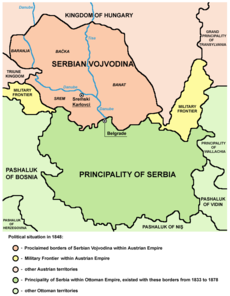 Proclaimed borders of Serbian Vojvodina at May Assembly (1848) and autonomous Ottoman Principality of Serbia
Proclaimed borders of Serbian Vojvodina at May Assembly (1848) and autonomous Ottoman Principality of Serbia
During the 1848-49 revolutions, Vojvodina was a site of war between Serbs and Hungarians, due to the opposite national conceptions of these two peoples. At the May Assembly in Sremski Karlovci (13–15 May 1848), Serbs declared the constitution of the Serbian Voivodship (Serbian Duchy), a Serbian autonomous region within the Austrian Empire. The Serbian Voivodship consisted of Syrmia, Bačka, Banat, and Baranja. The metropolitan of Sremski Karlovci, Josif Rajačić, was elected patriarch, while Stevan Šupljikac was chosen as first voivod (duke). The ethnic war hit this area perhaps the hardest, with terrible atrocities committed against the civilian populations by both sides.
Following the Habsburg and Serb victory over Hungarians in 1849, a new administrative territory was created in the region (in November 1849), in accordance with a decision made by the Austrian emperor. By this decision, Serbian autonomous region created in 1848 was transformed into the new Austrian crown land known as Voivodship of Serbia and Tamiš Banat. It consisted of Banat, Bačka and Syrmia, excluding the southern parts of these regions which were part of the Military Frontier. An Austrian governor seated in Temeschwar ruled the area, and the title of voivod belonged to the emperor himself. The full title of the emperor was "Grand Voivod of the Voivodship of Serbia" (German: Großwoiwode der Woiwodschaft Serbien). German and Illyrian (Serbian) were the official languages of the crown land. In 1860, the new province was abolished and most of it (with exception of Syrmia) was again included into Habsburg Kingdom of Hungary. Since 1867, Kingdom of Hungary is one of two self-governing parts of Austria-Hungary. The era following the Austro-Hungarian Compromise of 1867 was a period of economic flourishing, since Kingdom of Hungary had the second fastest growing economy in Europe between 1867–1913, but ethnic relations were strained. According to the 1910 census, the last census conducted in Austria-Hungary, population of Vojvodina included 510,754 (33.8%) Serbs, 425,672 (28.1%) Hungarians and 324,017 (21.4%) Germans.[36]
Serbian and Yugoslav administration
At the end of World War I, the Austro-Hungarian Empire collapsed. On 29 October 1918, Syrmia became a part of the State of Slovenes, Croats and Serbs. On 31 October 1918, the Banat Republic was proclaimed in Temeschwar. The government of Hungary recognized its independence, but it was short-lived.
On 25 November 1918, the Assembly of Serbs, Bunjevci, and other nations of Vojvodina in Novi Sad proclaimed the unification of Vojvodina (Banat, Bačka and Baranja) with the Kingdom of Serbia (The assembly numbered 757 deputies, of which 578 were Serbs, 84 Bunjevci, 62 Slovaks, 21 Rusyn, 6 Germans, 3 Šokci, 2 Croats and 1 Hungarian). One day before this, on 24 November, the Assembly of Syrmia also proclaimed the unification of Syrmia with Serbia. On 1 December 1918, Vojvodina (as part of the Kingdom of Serbia) officially became part of the Kingdom of Serbs, Croats and Slovenes.
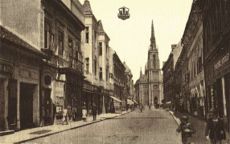 Novi Sad, historical capital of Vojvodina, in the 1920s.
Novi Sad, historical capital of Vojvodina, in the 1920s.
Between 1929 and 1941, the region was known as the Danube Banovina, a province of the Kingdom of Yugoslavia. Its capital city was Novi Sad. The Banovina consisted of the Syrmia, Bačka, Banat, Baranja, Šumadija, and Braničevo regions.
Between 1941 and 1944, during World War II, the Axis Powers divided and occupied Vojvodina. Bačka and Baranja were annexed by Horthy's Hungary and Syrmia was included into the Independent State of Croatia. A smaller Danube Banovina (including Banat, Šumadija, and Braničevo) existed as part of what was known as "Nedić's Serbia". The administrative center of this smaller province was Smederevo. However, Banat itself was a separate autonomous region ruled by its German minority. The occupying powers committed numerous crimes against the civilian population, especially against Serbs, Jews and Roma; the Jewish population of Vojvodina was almost completely killed or deported.[citation needed] In total, Axis authorities killed about 50,000 citizens of Vojvodina, while more than 280,000 people were interned, arrested, violated or tortured.[37]
Axis occupation ended in 1944 and the region was temporarily placed under military administration (1944–1945) run by the new communist authorities. During, and after the military administration, several thousands of citizens were killed - this affected mostly ethnic Germans, but also one part of Hungarian and Serb populations. Both, war-time Axis occupational authorities and post-war communities ones, run the concentration/prison camps in the territory of Vojvodina (See the List of concentration and internment camps). While war-time prisoners in these camps were mostly Jews, Serbs and communists, post-war camps were formed for ethnic Germans (Danube Swabians). Most of Vojvodina Germans (about 200,000) left from the region in 1944, together with defated German army.[38] Most of those who remained in the region (about 150,000) were sent to some of the villages cordoned off as prisons. It is estimated that some 48,447 Germans died in the camps from disease, hunger, malnutrition, mistreatment, and coldness. Some 8,049 Germans was killed by the partisans during military administration in Vojvodina after October 1944.[39][40][41] It is also estimated that post-war communist authorities killed some 20,000[42] Hungarians and some 23,000-24,000[43] Serbs. According to professor Dragoljub Živković, 47,000 ethnic Serbs was killed in Vojvodina during entire 1941-1948 period. About half of that number was killed by occupational forces and another half was killed by post-war communist authorities.[44]
The region was politically restored in 1944 (incorporating Syrmia, Banat, Bačka, and Baranja) and became an autonomous province of Serbia in 1945. Instead of the previous name (Danube Banovina), the region regained its historical name of Vojvodina, while its capital city remained Novi Sad. When final borders of Vojvodina were defined, Baranja was assigned to Croatia, while northern part of Mačva region was assigned to Vojvodina.
Legal status
At first, the province enjoyed only a small level of autonomy within Serbia, but it gained extensive rights of self-rule under the 1974 Yugoslav constitution, which gave both Kosovo and Vojvodina de facto veto power in the Serbian and Yugoslav parliaments, as changes to their status could not be made without the consent of the two Provincial Assemblies. The 1974 Serbian constitution, adopted at the same time, reiterated that "the Socialist Republic of Serbia comprises the Socialist Autonomous Province of Vojvodina and the Socialist Autonomous Province of Kosovo, which originated in the common struggle of nations and nationalities of Yugoslavia in the National Liberation War (the Second World War) and socialist revolution".
Under the rule of the Serbian president Slobodan Milošević, Vojvodina and Kosovo lost elements of statehood in September 1990. Vojvodina was still referred to as an autonomous province of Serbia, but most of its autonomous powers - including, crucially, its vote on the Yugoslav collective presidency - were transferred to the control of Belgrade. The province, however, still had its own parliament and government and some other autonomous functions as well.
The fall of Milošević in 2000 created a new climate for reform in Vojvodina. Following talks between the political parties, the level of the province's autonomy was increased by the omnibus law in 2002. The old statute of the Autonomous Province of Vojvodina dated from 1991 and has been deemed by the Serbian Parliament as outdated. The Vojvodina provincial assembly adopted a new statute on 15 October 2008, 89 of 120 councilors voted in favor of the bill, whilst 21 voted against. The Statute, partly amended, was approved by Parliament of Serbia on 30 November 2009 with 137 MPs in favor and 24 against. The Statute was officially proclaimed on 14 December 2009, in Novi Sad, and came into force on 1 January 2010.
Geography
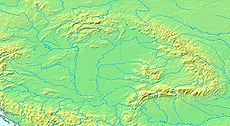 The Pannonian Plain (Vojvodina located at the southernmost part)
The Pannonian Plain (Vojvodina located at the southernmost part) Main article: Geography of Vojvodina
Main article: Geography of VojvodinaIt is located in the northern part of the country, in the Pannonian Plain of Central Europe. It has a population of about 2 million, about 27% of Serbia's total. The region is divided by the Danube and Tisza rivers into: Bačka in the northwest, Banat in the east and Syrmia (Srem) in the southwest. A small part of the Mačva region is also located in Vojvodina, in the Srem District. Today, the western part of Syrmia is in Croatia, the northern part of Bačka is in Hungary, the eastern part of Banat is in Romania (with a small piece in Hungary), while Baranja (which is between the Danube and the Drava) is in Hungary and Croatia. Vojvodina has a total surface area of 21,500 km2 (8,300 sq mi). Vojvodina is also part of the Danube-Kris-Mures-Tisa euroregion.
Districts and municipalities
After a constitution of Serbia from 1992, Vojvodina is divided into seven districts, which are called after its main geographical location. Districts are named after the main region which district covers. Minister of Local Government, in the Serbian Government appoints commissioners of the districts, but they have no political power. Local government lies in municipalities and cites. The seven districts are further subdivided into 43 municipalities and the cities of Novi Sad and Subotica.
District District seat with city status Municipalities Area (km²) Population (2002 census) Central Banat Zrenjanin Novi Bečej, Nova Crnja, Sečanj, Žitište 3,256 208,456 North Bačka Subotica Bačka Topola, Mali Iđoš 1,784 200,140 North Banat Kikinda1 Ada, Čoka, Kanjiža, Kikinda, Novi Kneževac, Senta 2,329 165,881 South Bačka Novi Sad Bač, Bačka Palanka, Bački Petrovac, Bečej, Beočin, Vrbas, Srbobran, Sremski Karlovci, Temerin, Titel, Žabalj 4,016 593,666 South Banat Pančevo Alibunar, Bela Crkva, Kovačica, Kovin, Opovo, Plandište, Vršac 4,245 313,937 Syrmia Sremska Mitrovica Inđija, Irig, Pećinci, Ruma, Šid, Stara Pazova 3,486 335,991 West Bačka Sombor Apatin, Kula, Odžaci 2,420 214,011 Total 21,500 2,031,992 1 - Kikinda is only district seat which does not have city status.
Cities
Largest cities of Vojvodina (with population figures):
- Novi Sad (284,252),
- Subotica (99,981),
- Zrenjanin (79,773),
- Pančevo (77,087),
- Sombor (51,471),
- Kikinda (41,935),
- Sremska Mitrovica (39,041),
- Vršac (36,001),
- Ruma (32,125),
- Bačka Palanka (29,431),
- Inđija (26,244),
- Vrbas (25,887),
- Bečej (25,703),
- Kovin (20,425),
- Senta (20,363),
- Kula (19,293),
- Apatin (19,289),
- Temerin (19,143),
Demographics
Main article: Demographic history of VojvodinaVojvodina is more diverse than the rest of Serbia with more than 25 ethnic groups and six official languages.[45]
The largest ethnic groups are Serbs (65%) and Hungarians (14%).[46]
Population by national or ethnic groups:[47][48]
Number % TOTAL 2,031,992 100 Serbs 1,357,320 65.05 Hungarians 290,207 14.28 Slovaks 56,637 2.79 Croats 56,546 2.78 Yugoslavs 49,881 2.45 Montenegrins 35,513 1.75 Romanians 30,419 1.5 Roma 29,057 1.43 Bunjevci 19,776 1.05 Pannonian Rusyns 15,626 0.77 Macedonians 11,785 0.58 Ukrainians 4,635 0.23 Muslims (by nationality) 3,634 0.18 Germans 3,154 0.16 Slovenes 2,005 0.1 Sokci 1,864 0.1 Albanians 1,695 0.08 Bulgarians 1,658 0.08 Czechs 1,648 0.08 Russians 940 0.05 Gorani 606 0.03 Bosniaks 417 0.02 Vlachs 101 0 Others 5,311 0.26 Regional identity 10,154 0.5 Undeclared 55,016 2.71 Unknown 23,774 1.17 Population by native language:
Number % Serbian language 1,557,020 76.63 Hungarian language 284,205 13.99 Slovak language 55,065 2.71 Romanian language 29,512 1.45 Romani language 21,939 1.08 Croatian language 21,053 1.04 Macedonian language 4,152 n/a Albanian language 2,369 n/a Bulgarian language 920 n/a Population by religion:
Number % Eastern Orthodox Christians 1,401,475 68.97 Catholics
(Roman Catholic and Eastern Rite)388,313 19.11 Protestants 72,159 3.55 Atheists 12,583 n/a Muslims 8,073 n/a Jews 329 n/a Oriental religions
(Buddhism, Hinduism etc.)166 n/a Others 4,456 n/a Without religious affiliation 418 n/a Undeclared 101,144 n/a Unknown 42,876 n/a Population by gender:
- 984,942 males
- 1,047,050 females
Population by age groups:
- 0–14 years: 15.85% (165,332 males, 156,873 females)
- 15–64 years: 68.62% (693,646 males, 700,416 females)
- 65 years and over: 15.53% (125,964 males, 189,761 females)
Source: Republic Statistical Office of Serbia
Politics
Main article: Politics of VojvodinaSee also: Vojvodina parliamentary election, 2008 and Statute of the Autonomous Province of VojvodinaThe current ruling coalition in the Vojvodina parliament (after 2008 elections) is composed of the following political parties: Democratic Party, G17 Plus, Hungarian Coalition, League of Social Democrats of Vojvodina, and Socialist Party of Serbia.
The current president of Vojvodinian government is Bojan Pajtić (Democratic Party), while the president of the Vojvodinian parliament is Sándor Egeresi (Hungarian Coalition).
Culture
 Zrenjanin, the main square.
Zrenjanin, the main square.
Vojvodina has a regional academy of science and art, Vojvodina Academy of Sciences and Arts. Its main aim is to cherish traditions in sciences and arts of the multicultural and multiethnic circle through cooperation with other academies and institutions and to improve life conditions of the Vojvodina region by using the spiritual and natural resources of Vojvodina. The Government of Vojvodina is the founder of several newspapers and magazines in Vojvodina's official languages: Дневник ("Daily news") in Serbian and Magyar Szó ("Hungarian Word") in Hungarian are daily newspapers, and weekly magazines are Hrvatska riječ ("Croatian Word") in Croatian, Hlas Ľudu ("The Voice of the People") in Slovak, Libertatea ("Freedom") in Romanian, and Руске слово ("Rusyn Word") in Rusyn. There is also Bunjevačke novine ("The Bunjevac newspaper") in Bunjevac. Hidden Europe article praises the cosmopolitism in the province.[49]
Tourism
Main article: Tourism in VojvodinaTourist destinations in Vojvodina include well known Orthodox monasteries on Fruška Gora mountain, numerous hunting grounds, cultural-historical monuments, different folklores, interesting galleries and museums, plain landscapes with a lot of greenery, big rivers, canals and lakes, sandy terrain Deliblatska Peščara ("the European Sahara"), etc. In the last few years, Exit has been very popular among the European summer music festivals.
Economy
The economy of Vojvodina is largely based on developed food industry and fertile agricultural soil that make up 84% of its territory. About 70% of agricultural products is corn, 20% industrial herbs, and 10% other agricultural cultures. Other branches of industry are also developed such as the metal industry, chemical industry, electrical industry, oil industry and construction industry. In the past decade, ICT sector has been growing rapidly and has taken significant role in Vojvodina's economic development.
Companies:
- Naftna Industrija Srbije
- Srbijagas
- Novosadski sajam
- HIP Petrohemija
Vojvodina promotes its investment potentials through Vojvodina Investment Promotion - VIP, investment promotion agency founded by the Parliament of the Autonomous Province of Vojvodina.
Human rights
Further information: Human rights in SerbiaIn 2005, several international organizations including the European Parliament and Human Rights Watch have expressed concern about rising levels of ethnic tension and related violent incidents in Vojvodina.[50] Of particular concern, according to the reports, is a frequently lax response on the part of the police.
Gallery
-
Serbian Orthodox church in Srbobran
-
Catholic (historically German) Church in Vršac
-
Catholic (Hungarian) Church in Kanjiža
-
Sombor in 1905
-
Serbs in Vojvodina in traditional clothes
-
Hungarians in Vojvodina in traditional clothes in a folk festival
-
The Evangelical (Slovak) church in Kovačica
-
Masjid of Islamic Religious Community in Novi Sad
-
Bunjevci in traditional clothes
-
The Uniate (Rusyn) cathedral in Ruski Krstur
-
Catholic (Croat / Šokac) Church in Sonta
-
The Romanian Orthodox church in Vršac
See also
- Bačka
- Banat
- Syrmia
- Mačva
- Ethnic groups of Vojvodina
- Statute of the Autonomous Province of Vojvodina
- Crimes of the occupants in Vojvodina, 1941-1944
- 1942 raid in Novi Sad
- 1944-1945 killings in Bačka
References
- ^ Skordisci: istorija i kultura, Jovan Todorović, Institut za izučavanje istorije Vojvodine, 1974, page 268.
- ^ The Roman war of Antiochos the Great, John D. Grainger, BRILL, 2002, page 82.
- ^ The Celtic Encyclopedia, Том 1, Harry Mountain, Universal-Publishers, 1998, page 215.
- ^ http://histoiremesure.revues.org/880
- ^ http://usuarios.multimania.es/superjulio/IMPERIOS%20BALCANICOS/Mapas%20Imperiales%20Imperio%20de%20Burebista%20de%20Dacia2.jpg
- ^ http://usuarios.multimania.es/superjulio/IMPERIOS%20BALCANICOS/Mapas%20Imperiales%20Imperio%20de%20Burebista%20de%20Dacia1.jpg
- ^ http://talcuireapocalipsa.files.wordpress.com/2010/12/dacia-burebista.jpg
- ^ http://juriscult.files.wordpress.com/2011/05/burebistahartadacia1.jpg
- ^ http://www.mdn.md/biblioteca/images/05DaciaBurebista-01-01.jpg
- ^ http://keptar.niif.hu/000500/000586/magyaro-honf-terkep_nagykep.jpg
- ^ http://www.crohis.com/srkulj1/trpimir.jpg
- ^ http://www.zeitlerweb.com/img/775pxGreat_Moravia.jpg
- ^ http://nd01.jxs.cz/988/783/895de26d69_51179296_o2.jpg
- ^ http://www.provitacz.cz/public/upload/products/3183_velka_morava.jpg
- ^ http://1.bp.blogspot.com/_z5j3wjkIaUw/THPQKJT_QpI/AAAAAAAAAZ8/V1VKogfh4eU/s1600/1986_86-01_08_Puspoki1_original.jpg
- ^ http://keptar.niif.hu/000500/000586/magyaro-honf-terkep_nagykep.jpg
- ^ http://keptar.niif.hu/000500/000586/magyaro-honf-terkep_nagykep.jpg
- ^ The Austrian military border: its political and cultural impact, Liviu Maior, Nicolae Bocșan, Ioan Bolovan, Glasul Bucovinei, 1994, page 66.
- ^ Slavonic encyclopaedia, Joseph Slabey Rouček, Philosophical Library, 1949, page 505.
- ^ Srpsko srednjevekovno selo, Branko Peruničić, Naučna kniga, 1956, page 49.
- ^ Srbi u Rumuniji, Ljubivoje Cerović, Ljubomir Stepanov, Savez Srba u Rumuniji, 2000, page 29.
- ^ Arhivski pregled, Društvo arhivskih radnika SR Srbije, Državna arhiva NR Srbije, 1990, page 88.
- ^ Farrow's military encyclopedia: a dictionary of military knowledge, Edward Samuel Farrow, Military-Naval Publishing Company, 1895, page 345.
- ^ Encyclopaedia Britannica: a dictionary of arts, sciences, and general literature, Том 12, William Harrison De Puy, R.S. Peale, 1891, page 361.
- ^ The World's History: South-eastern and eastern Europe, Viscount James Bryce Bryce, William Heinemann, 1907, page 303.
- ^ The Catholic encyclopedia: an international work of reference on the constitution, doctrine, discipline, and history of the Catholic church, Том 4, Charles George Herbermann, The Catholic Encyclopedia Inc., 1913, page 512.
- ^ http://www.terra.es/personal7/jqvaraderey/181815ge.gif
- ^ http://www.historyonmaps.com/ColourSamples/cbig/DissolutionMilitayFrontier.jpg
- ^ http://www.bosnjaci.net/foto/Bosna_i_Evropa1.jpg
- ^ http://www.uncp.edu/home/rwb/slavs_map.jpg
- ^ http://www.home-edu.ru/user/uatml/00000628/rumjancev/drevnieslavjane/rasselenie.jpg
- ^ http://ark.wz.cz/ib/slavic_expansion.jpg
- ^ http://www.blic.rs/Vesti/Vojvodina/997/Slovenski-grobovi-uz-reku-Galadsku
- ^ http://www.scribd.com/doc/31770589/Obicaji-i-Verovanja-Slovena-Na-Tlu-Danasnje-Vojvodine
- ^ http://www.memo.fr/Media/Salves-X-XIIe.jpg
- ^ http://www.hungarian-history.hu/lib/hmcb/Tab21.htm
- ^ Dr Dušan Popov, Vojvodina, Enciklopedija Novog Sada, sveska 5, Novi Sad, 1996, page 196.
- ^ Dragomir Jankov, Vojvodina - propadanje jednog regiona, Novi Sad, 2004, page 76.
- ^ Nenad Stefanović, Jedan svet na Dunavu, Beograd, 2003, page 133.
- ^ de Zayas.
- ^ Zoran Janjetovic, Between Hitler and Tito, 2005.
- ^ Dragomir Jankov, Vojvodina – propadanje jednog regiona, Novi Sad, 2004, page 78.
- ^ Srbe podjednako ubijali okupatori i „oslobodioci”
- ^ Srbe podjednako ubijali okupatori i „oslobodioci”
- ^ Johnstone, Sarah (2007). Europe on a shoestring. Lonely Planet. pp. 981. ISBN 9781741045918.
- ^ http://webrzs.stat.gov.rs/axd/en/popis.htm
- ^ http://www.vojvodina.gov.rs/index.php?option=com_content&task=view&id=100&Itemid=68
- ^ http://webrzs.stat.gov.rs/axd/en/popis.htm
- ^ hidden europe magazine - Articles - hidden europe 13 (March 2007) - two communities in Banat
by Laurence Mitchell - ^ Dangerous Indifference: Violence against Minorities in Serbia: Assaults on Minorities in Vojvodina
External links
- (English) (Serbian) Government of the Autonomous Province of Vojvodina
- (English) (Serbian) Provincial Secretariat for Regional and International Cooperation
- Useful information about Vojvodina, Parks of Nature, River Expedition, Wine Trails, Cities, Etno, Adventure and more
- Interactive map of Novi Sad
- Atlas of Vojvodina (Wikimedia Commons)
- Statistical information about municipalities of Vojvodina
- List of largest cities of Vojvodina
- (Hungarian) The encyclopedia of Vojvodina
Categories:- Vojvodina
- Subdivisions of Serbia
- Statistical regions of Serbia
- States and territories established in 1945
- Historical regions in Serbia
- Autonomous provinces
Wikimedia Foundation. 2010.

